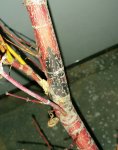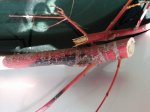If that is what it is remove the tree from the area - serious, that spread and killed all I had last Spring.
The treatment for the soil and EVERYTHING related is Agri-mycin 17 which is an Agricultural Streptomycin. I used the Nu-Farm brand and the representative is Ross Huneycutt @ Nufarm 919.244.4098.
My plants all suffered most of these symptoms and were all sent to Land Fill for proper disposal -
Plant Symptoms Caused by Pseudomonas syringae
A variety of symptoms are associated with woody plants infected by Pseudomonas syringae pv. syringae. Symptoms and symptom development depend on the species of plant infected, the plant part infected, the strain of Pseudomonas syringae, and the environment. More than one symptom can be simultaneously on a single plant.
•Flower blast: flowers and/or flower buds turn brown to black.
•Dead dormant buds, common on cherries and apricots.
•Necrotic leaf spots (entire clusters of younger, expanding leaves may be killed on filbert trees).
•Discolored and or blackened leaf veins and petioles resulting from systemic invasion and infection.
•Spots and blisters on fruit.
•Shoot-tip dieback, which appears as dead, blackened twig tissue extending down some distance from the tip (very common on maples and other seedlings).
•Stem cankers: depressed areas in the bark, which darken with age. A gummy substance often exudes from cankers on fruiting and flowering stone fruits (this symptom is referred to as “gummosis”). If cankers continue to enlarge, they may girdle the stem and subsequently kill a branch or the entire plant. IF the outer tissues of the canker area are cut away, the tissue underneath shows a reddish brown discoloration. This discoloration may also occur as vertical streaks in the vascular tissue.
Make sure you take the plant in the soil so the soil can be tested and soil samples close by carefully numbered...
I really HOPE it is NOT and just fungal craziness -
Grimmy


